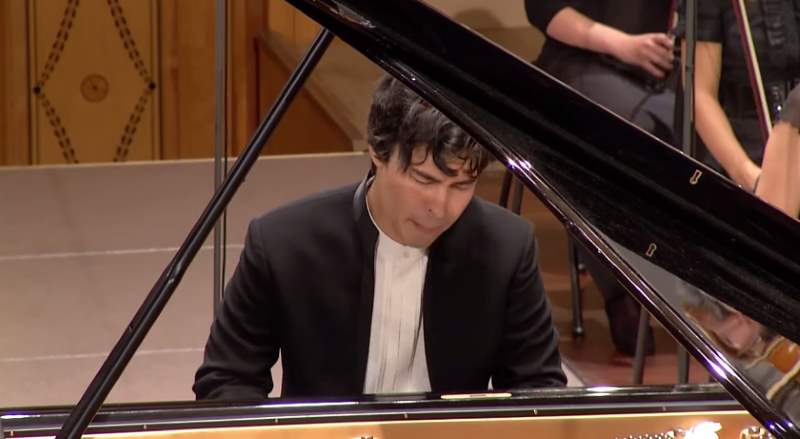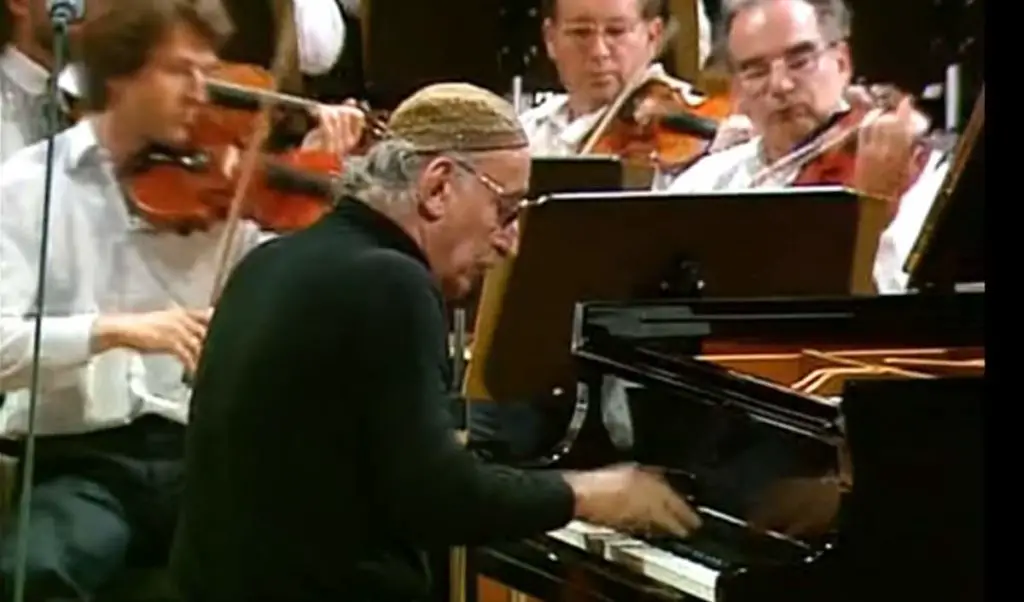Accompanied by the hr-Sinfonieorchester (Frankfurt Radio Symphony Orchestra), German-Korean pianist Christopher Park performs Wolfgang Amadeus Mozart’s Piano Concerto No. 20 in D minor, K. 466. Conductor: Paavo Järvi. Recorded at the Rheingau Musik Festival 2013 at Wiesbaden, Kurhaus. August 21, 2013.
Mozart’s Piano Concerto No. 20
Mozart’s Piano Concerto No. 20 in D minor, K. 466, composed in 1785, is one of his most powerful and dramatic concertos, known for its intense emotional depth and innovative structure. Unlike many of his other concertos, which are often bright and joyful, No. 20 is set in D minor, a key associated with tension and darkness. This concerto marked a new chapter in Mozart’s concerto writing, bringing a heightened sense of drama and complexity that distinguished it from his earlier works. Premiered on February 11, 1785, with Mozart himself at the piano, the piece was composed during a prolific period in his life when he was already gaining acclaim as both a composer and a performer in Vienna.
The concerto’s minor tonality and dynamic contrasts contribute to a mood of suspense, underscoring the restless and sometimes turbulent character of the music. Mozart’s orchestration is particularly notable, as he expands the orchestra with the addition of trumpets and timpani, unusual choices for a piano concerto. These instruments enhance the dramatic scope of the work, amplifying the darker tones and providing a forceful underpinning to the soloist’s part. The concerto explores a wide emotional range, from introspective melancholy to moments of intense vigor and passion. This expressive breadth has made Piano Concerto No. 20 a favorite among audiences and performers alike, resonating with those who are drawn to its complex, almost operatic narrative.
What makes this concerto especially innovative is Mozart’s use of the orchestra and piano in close, dynamic dialogue. Rather than simply having the orchestra accompany the soloist, he allows each to contribute to the development of the themes, creating an interplay that enhances the dramatic effect. The piano part is technically demanding, filled with intricate passages that require both agility and sensitivity, especially as it navigates the tension between dark, dramatic sections and more lyrical interludes. This concerto’s depth of expression inspired composers like Beethoven, who admired it so much that he wrote his own cadenzas for the piece.
Piano Concerto No. 20 is celebrated not only for its technical brilliance but also for its ability to convey a sense of struggle, tension, and resolution, making it one of the most profound works in Mozart’s piano repertoire. Its influence extends far beyond Mozart’s time, as it opened the door to a more expressive, Romantic approach in concerto writing, inspiring generations of composers to explore new emotional possibilities within the form.
Movements
1. Allegro (in D minor)
The first movement of Mozart’s Piano Concerto No. 20 in D minor, K. 466, marked Allegro, is strikingly dark and intense, setting the tone for the concerto with a sense of urgency and drama. It opens with a brooding orchestral introduction, where violins lead with an ominous theme over a sparse, pulsing accompaniment, immediately capturing the listener’s attention. The music is charged with a tense energy, with sharp dynamic contrasts and an underlying rhythmic drive that suggests something foreboding. This opening in D minor, a key often associated with tragedy and drama in Mozart’s work, establishes a mood of restlessness and suspense.
When the solo piano enters, it initially mirrors the orchestra’s dramatic theme but quickly introduces more lyrical, flowing lines, creating a compelling contrast between tension and delicacy. Mozart’s use of minor and major keys throughout the movement enhances this duality, with darker, more intense passages transitioning into moments of fleeting lightness. The piano engages in a vivid dialogue with the orchestra, contributing to the development of themes rather than merely following or echoing the orchestral part. This exchange allows the soloist to explore a wide range of emotions, moving from reflective passages to bursts of intensity with seamless transitions.
Mozart’s orchestration in this movement is bold, with the addition of trumpets and timpani to the standard concerto ensemble, lending a greater sense of weight and impact to the music. The movement builds toward a powerful climax before reaching a quieter, contemplative passage, only to surge once again with renewed intensity. The first movement’s haunting character and complex interplay between piano and orchestra make it one of Mozart’s most emotionally charged and sophisticated concerto openings, highlighting his gift for creating music that speaks directly to the human experience of struggle and resilience.
2. Romanza (in B-flat major)
The second movement of Mozart’s Piano Concerto No. 20 in D minor, K. 466, titled Romanza, offers a gentle, lyrical contrast to the intensity of the first movement. Set in B-flat major, Romanza introduces a warm, tender melody that brings a sense of calm and introspection. The choice of a major key creates a serene and almost idyllic atmosphere, transporting the listener into a tranquil world far removed from the stormy D minor of the first movement.
The piano opens with a delicate, song-like theme that unfolds with simplicity and grace, evoking the feeling of a reflective lullaby. Mozart’s lyrical approach here demonstrates his ability to craft melodies that are both beautiful and deeply expressive, enhancing the concerto’s emotional depth.
In the orchestral accompaniment, strings and winds gently support the piano, creating a balanced dialogue that allows the soloist’s introspective melody to shine. The movement follows a rondo-like form, with the main theme returning several times, each time bringing a sense of familiarity and warmth. Yet within this structure, Mozart introduces contrasting episodes that add variety and emotional nuance.
One particularly striking passage returns to the minor mode, shifting the mood briefly to a more dramatic, introspective tone before resolving back to the tranquility of the main theme. This interplay between light and shadow adds richness to the movement, hinting at underlying emotions without disrupting the overall sense of peace.
The Romanza is a showcase of Mozart’s sensitivity to musical color and texture, as he effortlessly weaves together gentle piano phrases with subtle orchestral shades. Its flowing melodies and tender harmonies create a moment of repose within the concerto, offering listeners a glimpse of beauty and solace before the return of darker, more turbulent themes in the final movement. The Romanza remains one of Mozart’s most beloved slow movements, celebrated for its elegance, warmth, and emotional subtlety.
3. Allegro assai (in D minor, ending in D major)
The third movement of Mozart’s Piano Concerto No. 20 in D minor, K. 466, marked Allegro assai, reintroduces the intensity and urgency of the opening movement, creating a powerful and spirited conclusion. Beginning in D minor, this movement features a lively, almost restless theme that drives forward with relentless energy, capturing a sense of urgency and excitement.
The movement is structured as a sonata-rondo, allowing Mozart to present the theme in several variations, each with its own distinctive character. The orchestra opens with a bold, rhythmic statement, quickly echoed by the piano, which adds flourishes and variation to the initial theme. This quick back-and-forth between the piano and orchestra creates an engaging, dynamic interplay that sustains the listener’s interest.
The contrasting episodes within the movement add moments of brightness and even humor, momentarily lifting the darker mood. These sections reveal Mozart’s skill at blending contrasting emotions within a single movement, as moments of lightness interject into the tension-filled main theme. However, the music continually returns to the more intense, minor passages, keeping the audience on edge and underscoring the concerto’s dramatic core.
As the movement progresses, Mozart skillfully transitions from D minor to D major, leading to a triumphant and joyful conclusion. This shift to the major key brings a sense of resolution and victory, ending the concerto on a high note. The final D major section is filled with exuberance and brightness, as the piano and orchestra join in a jubilant, celebratory dialogue.
This transformation from minor to major gives the piece a sense of closure, as if the struggles of the earlier movements have been overcome, allowing the concerto to end on a note of optimism and joy. The Allegro assai is a testament to Mozart’s ability to weave intensity, contrast, and ultimately, resolution into a single movement, creating an unforgettable and exhilarating finale.
Christopher Park
Born in Bamberg, Germany (30 July 1987), Christopher Park received his first piano lessons at the age of 7.
As a young student at the age of 12, Christopher Park was accepted into the class of Prof. Thomas Duis. In the past few years, Mr. Park won several international competitions around the world, among these in New York, Hamburg, Nürnberg, and Rhodes.
In 2004, Park was introduced to Prof. Lev Natochenny, himself a rare disciple of legendary Lev Oborin and David Oistrakh, and has been accepted into his famous “Meisterklasse” at the University of Music and Performing Arts in Frankfurt am Main.

Through master classes and concerts, including performances at the Weilburger Schlosskonzerte, the Frankfurt Fest der Musik, Alte Oper, Summit Music Festival in New York and Burgos, Christopher Park received musical inspiration from such luminaries as Lev Natochenny, Gary Graffman, Cyprien Katsaris, Karl-Heinz Kämmerling, Vladimir Krainev, and Lars Vogt, to name a few.
These valuable experiences and studies gave him the opportunity to perform concerts in Germany, Greece, Italy, Spain, France, and the United States. Christopher Park also recorded for German Radio and Television broadcasts.
In January 2008 the young pianist was awarded the Culture Prize 2008 of the Hauck & Aufhäuser Cultural Foundation for his outstanding musical accomplishments. After that, he became the recipient of the Arte Musica Foundation scholarship.
In addition to his career as a soloist, Mr. Park is involved both in concert, as well as in CD recordings in chamber music and vocal accompaniment, which he has made with such illustrious musicians as Richard Yongjae O’Neill and Sumi Jo.
Sources
- Piano Concerto No. 20 (Mozart) on Wikipedia
- Wolfgang Amadeus Mozart’s Piano Concerto # 20 in d minor on ClassicalNotes.net
- Piano Concerto No. 20 in D minor, K. 466 (Mozart, Wolfgang Amadeus) on the International Music Score Library website
- Mozart’s Piano Concerto No. 20 on the Sofia Philharmonic website
- “Mozart: Piano Concerto No. 20 in D minor, K. 466” on the L.A. Phil website
- “Mozart’s Dark Side: The Piano Concerto No. 20 in D minor” on the Houston Symphony Orchestra’s website
- “Mozart’s Piano Concerto No. 20 in D Minor: Shadowy and Tempestuous” on The Listeners’ Club website


